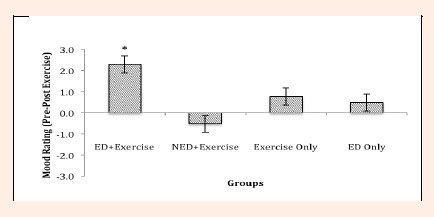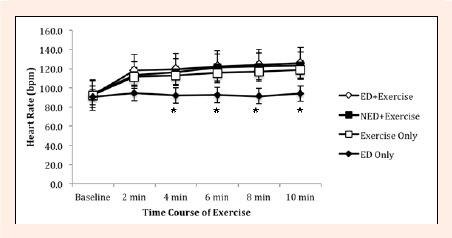Abstract
The hypothesis that an enjoyable distraction during exercise will augment the intensity of positive mood post-exercise was tested. A sample of 84 undergraduate students rated their mood and arousal before and after a standardized exercise, which consisted of walking on a treadmill at a pace of 3.6 mph for 10 minutes. During the work out session, participants watched the same television show, which they previously rated as enjoyable, or not enjoyable. As added controls, a third group exercised with no distraction (the TV was turned off); a fourth group did not exercise, but watched the television show. The results showed that exercise alone was sufficient to increase pleasant mood (95% CI 0.61, 1.46) and that including an enjoyable distraction during exercise significantly augmented pleasant mood compared to all other groups (95% CI 1.58, 2.99; R2 = 0.29). These results show that the enjoyment of a distraction is a key factor that can augment the intensity of positive mood following exercise.
Key points.
The hypothesis that an enjoyable distraction during exercise will augment the intensity of positive mood post-exercise was tested.
The results support this hypothesis by showing for the first time that while exercise alone was sufficient to increase the intensity of positive mood; combining exercise with an enjoyable distraction resulted in significantly greater increases in pleasant mood compared to exercise alone.
Accounting for the enjoyment of a distraction type in future studies can increase the sensitivity of research designs used to detect changes in positive mood post-exercise.
Key words: Distraction, exercise, aerobic, mood, enjoyment
Introduction
A growing body of literature demonstrates that exercise can enhance well-being and mood (Berger and Motl, 2000; Biddle, 2000; Otto and Smits, 2011) and may even be used to treat moderate to major depression (Barbour et al., 2007). Thus, understanding the underlying mechanisms associated with increasing the intensity of pleasant mood can be beneficial. Mechanisms identified to explain the pleasant effects of exercise on mood include psychological factors, social processes, and physiological factors (Ekkekakis and Petruzzello, 1999; Russell et al., 2003; Schutzer and Graves, 2004). Exercise can increase the intensity of pleasant mood with cardiovascular and weight training (Rocheleau et al., 2004), exercise on a stationary bike or treadmill at a self-selected workload (Rendi et al., 2008), and low-exertion exercise (Netz and Lindor, 2003).
The distractions or surroundings of the exercise setting itself have also been tested as possible factors that may enhance mood during exercise. Listening to music (Hayakawa et al., 2000; Macone et al., 2006), and watching television or reading (Russell et al., 2003) during exercise have been tested as potential factors associated with the increased intensity of pleasant mood during exercise. The extent to which distractions during exercise can enhance pleasant mood is of particular interest to researchers because it could possibly augment (enhance further) the effects of exercise on increasing the intensity of pleasant mood, which could lead to the continuation of a workout routine (Rocheleau et al., 2004).
Yet, while many studies show a consistent pattern of increased pleasant mood following exercise, across multiple sessions and even across a single session (Daley and Welch, 2004; Ekkekakis et al., 2011; Reed and Ones, 2006), there has been inconsistent reporting of how distractions during exercise contribute to pleasant mood changes post-exercise (Berger et al., 2000; Russell et al., 2003). For example, one study showed that exercise enhanced overall mood, as expected, but that including two common distractions during exercise (television watching, reading) did not augment these mood changes more so than exercise alone (Russell et al., 2003). The authors suggested that certain distractors during exercise would be more effective than others at enhancing mood.
In the present study, we examined one possible factor contributing to the effectiveness of distractions on exercise: the enjoyment of the distraction. At present, “distractions” have been treated as standardized, with little effort to identify the extent to which the participants actually enjoy the distraction. For example, participants “watch television” or “read” but the extent to which they desire to do this or the extent to which they enjoy what they are watching or reading has not been identified, despite evidence for increased pleasant mood following more enjoyable activities (Berger, 1996; Wankel, 1993).
Overall, studies show evidence that the more enjoyable an exercise task is to a participant, the more pleasant the mood changes post-exercise (Motl et al., 2000; Raedeke, 2007). We therefore surmised that if an enjoyable exercise activity can enhance mood, then including an enjoyable distraction during a standardize exercise activity could act to augment pleasant mood changes post-exercise. To test this hypothesis, we therefore manipulated the enjoyment of a distraction during exercise, as identified by participants in our study, and compared changes in self-reported affect/mood pre- and post-exercise using an adapted version of the affect grid (Russell et al., 1989).
Methods
Participants
A sample of 84 undergraduate student volunteers (52 women, 32 men) was recruited through university classroom visits and sign-up sheets. Participant sample characteristics were (M±SD) age (19.8 ± 0.9 years), weight (73 ± 6.4 kg), height (1.77 ± 0.05 m), and BMI (24.8 ± 3.2 kg·m-2). The 84 participants passed an initial screening used to determine if individuals qualified to participate. All participants were light to moderate exercisers (from 0.5 to 1.5 hours of exercise per week), and were non-smokers who were in general good health with no physical or physician/doctor diagnosed medical conditions including pregnancy, and no dietary or exercise restrictions. Also, all participants ate within the range of 1 to 2 hours prior to the study to control for differences in hunger states, which can otherwise influence changes in affect/mood and arousal (Frank et al., 2010; Privitera et al., 2013).
Measures and equipment
Treadmill: Participants walked on a Life Fitness® 95T InspireTM Treadmill (1 × w × h: 2 m × 1 m × 1.5 m) at a standardized walking pace of 3.6 mph for 10 min, which is a sufficient exercise intensity to observe post-exercise changes in mood (Ekkekakis et al., 2000; Hansen et al., 2001). The treadmill had an attached 43 cm LCD television on top of the 18 cm LCD InspireTM Console, and a video clip streamed on the television screen from an iPod® through a USB cord. Heart rate was also measured using hand sensors attached to the treadmill in beats per minute (bpm).
Video clip: All participants watched the same 10 minute (min) episode clip of “Two and a Half Men,” which is a popular sitcom in the U.S. The clip used was a 10 min segment from Season 1, Episode 17, titled, “Ate the Hamburgers, Wearing the Hats,” which first aired on February 23, 2004. The clip had no commercials, and the content in the clip was selected such that any vulgar or offensive scenes or language were omitted from the video clip. Familiarity with the episode was the same between groups: The number of participants in each group who had, and had not, watched the episode of the video clip chosen was the same.
Mood and arousal ratings: Participants reported changes in mood and arousal using an adapted version of the affect grid (Russell et al., 1989), a single-item scale that assesses two dimensions of affect states: mood (pleasant feelings vs. unpleasant feelings) and arousal (excitement vs. sleepiness or calmness). The scale was completed at two times; the difference in ratings from Time 1 to Time 2 was recorded. Negative difference scores indicate a decrease in mood/arousal; positive difference scores indicate an increase in mood/arousal.
Procedures
The study was split into two phases: A grouping phase to assign participants to groups (n = 21 per group), and a study phase to conduct the research procedures. The university’s Institutional Review Board approved all procedures.
Grouping phase: Participants were assigned to one of four groups depending on how enjoyable they rated the show “Two and a Half Men.” Participants completed a survey ranking nine popular television shows in the U.S in order of how they enjoyed watching those shows. All participants confirmed that they had at least viewed each of the shows on the list. Participants rating “Two and a Half Men” in the top 3 (among their most enjoyable shows) were assigned to the ED (enjoyable distraction) + Exercise group; those rating “Two and a Half Men” in the bottom 3 (among their least enjoyable shows) were assigned to the NED (not as enjoyable distraction) + Exercise group; those rating Two and a Half Men in the middle 3 (a neutral rating) were assigned to exercise without a distraction (Exercise Only group); in a fourth group, participants rating “Two and a Half Men” in the top 3 were assigned to an ED Only group, which allowed for a comparison of this group with the ED + Exercise group to determine if adding an ED can augment pleasant mood post-exercise.
Study phase: In the study phase all participants were observed in a university gymnasium setting. A section of the gym was reserved for use in the study to separate study participants from the general gym population and to avoid additional distractions beyond those manipulated in this study. Upon arrival in the gym, participants were given and signed an informed consent. Participants then completed 5 min of quiet rest to prime a neutral emotional state (Privitera et al., 2013) before rating their pre-exercise levels of mood and arousal.
Participants in the exercise groups then began their exercise by walking on a treadmill at the standardized speed of 3.6 mph for 10 min (walking speed). According to the Centers for Disease Control and Prevention, walking is the most popular aerobic physical exercise among adults (CDC, 2013). For this reason, we chose a walking exercise at a “brisk” walking pace (1) to hold constant the intensity of the exercise, and (2) to use a type of low-exertion physical exercise (i.e., walking) that is most popular among adults who exercise.
Participants in the ED + Exercise, the NED + Exercise, and the ED Only groups watched the same video clip of “Two and a Half Men” during the 10 min. Participants who did not exercise (ED Only group) stood on the treadmill while watching the video clip so as to be treated the same as participants in the exercise groups (minus actually exercising). All participants were told only to look forward (toward the television screen) or to look down (to check their footing); all participants followed these instructions. The television screen was turned off during exercise for participants in the Exercise Only group.
Participant heart rate was recorded in all groups at the start of the exercise/10 min (baseline) and in 2 min intervals for 10 min to check the exercise intensity levels in the exercise and no exercise groups (Karvonen and Vuorimaa, 1988; Rezk et al., 2006). All participants in the exercise groups completed the full 10 min exercise. Following the exercise/10 min, participants were given a 5 min rest period, then rated their post-exercise levels of mood and arousal. The rest period is within the timeframe that changes in affect/mood states have been reported post-exercise (Ekkekakis et al., 2011; Steptoe and Cox, 1988). Once participant ratings were completed, participants were debriefed and dismissed.
Data analyses
A one-way between-subjects ANOVA was computed with groups as the between-subjects factor and mood and arousal ratings as the dependent variables. Tukey’s HSD was used as the post hoc test. Sex was also included as a factor, but removed when it showed no significance with the effects reported here. To check if changes in mood were evident within each group, 95% confidence intervals (CIs) were drawn for differences in mood and arousal scores. The null hypothesis under evaluation for each group was that the mean difference score in the population was zero. A change in mood or arousal was identified if the 95% CI did not envelop zero.
To check if participants in each exercise group showed similar exertion during exercise and compared to the no exercise control group, a two-way mixed factorial ANOVA was also computed with heart rate as the dependent variable. Time (Baseline, 2, 4, 6, 8, and 10 min) was the within-subjects factor and groups were the between-subjects factor. All tests were conducted at a .05 level of significance.
Results
With mood as the dependent variable, an effect of groups was significant, F(3, 80) = 10.89, p < 0.001, R2 = 0.29. Post hoc tests showed that compared to all other groups, participants in Group ED + Exercise showed the largest increase in the intensity of pleasant mood post-exercise (Tukey’s HSD, p < 0.02 for all tests), as shown in Figure 1. Within group comparisons also showed that Group ED + Exercise (95% CI 1.58, 2.99), and Group Exercise Only (95% CI 0.61, 1.46) significantly increased the intensity of pleasant mood post-exercise. No change in the intensity of pleasant mood was evident in Group NED + Exercise (95% CI -1.23, 0.18), and Group ED Only (95% CI -0.23, 1.18). With arousal as the dependent variable, no significant changes were evident between groups, p = 0.56. Within group comparisons also showed no change in arousal (i.e., the 95% CI for all groups enveloped zero).
Figure 1.

Mean change in pleasant mood in each group pre-post exercise. An asterisk indicates significance at p < 0.02 compared to all other groups. Error bars indicate standard error of the mean (SEM).
The factorial ANOVA showed that heart rate significantly increased over time during the exercise/10 min, F(5, 400) = 108.95, p < 0.001, R2 = 0.58, and that this change depended on group assignment, F(15, 400) = 10.80, p < 0.001, R2 = 0.29. As shown in Figure 2, post hoc tests confirmed that heart rate was the same in all groups at baseline, and significantly lower in the group that did not exercise (Group ED Only) compared to the exercise groups at each 2-min interval beginning at 4 min, p < 0.05 for all tests. Heart rate was statistically similar in the three exercise groups confirming that the intensity of the exercise did not significantly vary among groups who did exercise. A main effect of groups was also evident, F(3, 80) = 29.62, p < 0.001, R2 = 0.53, indicating that heart rate in Group ED Only was significantly lower across the full 10 min session compared to the exercise groups. No further significant changes were evident.
Figure 2.

Mean heart rate among participants in the exercise groups and in the no exercise group. An asterisk indicates significantly lower heart rate in the ED Only group compared to the exercise groups at p < 0.05. Error bars indicate SEM.
Discussion
The hypothesis that an enjoyable distraction during exercise will enhance mood post-exercise was tested. The results presented here show support for this hypothesis by showing an augmentation effect of an enjoyable distraction on mood: While exercise alone was sufficient to increase the intensity of pleasant mood; combining exercise with an enjoyable distraction resulted in a significantly greater increase in pleasant mood compared to exercise alone. Participants watching the same show during exercise but who rated it as not enjoyable and those who did not exercise showed no changes in mood pre- to post-exercise. Hence, exercise alone increased the intensity of pleasant mood, and an enjoyable distraction during exercise significantly augmented pleasant mood changes compared to exercise alone.
Some alternative explanations can be eliminated because of the controls included in the design. Heart rate data confirmed that the intensity of the exercise was the same for all exercise groups. Therefore, differences between the exercise groups are likely to be explained by differences in the distraction, with a more enjoyable distraction resulting in more pleasant changes in mood post-exercise. Thus, the enjoyable distraction during exercise was necessary to see the augmentation effect on mood observed here, although exercise alone was sufficient to see within-group changes in mood. Exercise alone would be expected to increase the intensity of pleasant mood even in a single session for 10 min (Hansen et al., 2001; Steptoe et al., 1988); the new outcome reported here is that an enjoyable distraction during exercise can augment the increased intensity of pleasant mood post-exercise compared to exercise alone.
To date, there has been rather inconsistent reporting of how distractions during exercise contribute to pleasant mood changes post-exercise (Russell et al., 2003). The results presented here provide a possible explanation for why effects of distraction on mood are inconsistently reported: because mood changes are dependent on the type of distraction during exercise, with more enjoyable distractions being associated with more pleasant mood changes. Hence, studies that fail to show an effect of distraction on mood post-exercise, may fail to detect the effect because, at random, some participants enjoy the distraction and some do not—thereby cancelling each other out if treated as one group. As evidence for this possibility in the present study, showing a video that was not enjoyable during exercise (Group NED + Exercise) did not significantly change mood, which may have resulted because exercise itself was enjoyable but the distraction was not; thus watching the non-enjoyable distraction during exercise could have counteracted the possible pleasant effects of exercise in this group (Biddle, 2000; Reed and Ones, 2006).
Because of the nature of the study design, the type of distraction was a quasi-independent variable. Participants selected themselves to each distraction type group based on their responses to ranking their favorite television shows. Hence, one possible limitation to this study is selection differences among people who enjoy the show “Two and a Half Men” and those who do not enjoy the show. Also, because only one genre of video was used (i.e., a comedy), it cannot be determined if other types of distractions (e.g., dramas, action films) will have a similar effect on pleasant mood during exercise. Future studies can investigate these possibilities, by selecting participants to experience many different types and genres of distractions during exercise to identify the generality of the effects reported here.
More studies are certainly needed to identify the specific mechanisms in a distraction that lead to or cause the increased intensity of pleasant mood (other than individual differences). Still, these results suggest that accounting for the enjoyment of a distraction type in future studies can nevertheless increase the sensitivity of research designs used to detect changes in post-exercise mood. Also, the results presented here demonstrate that an enjoyable distraction during exercise can increase pleasant mood post-exercise, which could have possible therapeutic effects in a gym setting among college-aged samples.
Conclusion
The results presented here show evidence for one possible factor contributing to the effectiveness of distractions on exercise: the enjoyment of the distraction. The results show support for the conclusion that watching an enjoyable distraction during exercise can augment the positive effects of exercise on mood. Future studies that manipulate distractions during exercise should account for this factor to increase the sensitivity of their research designs to detect changes in mood following exercise.
Biographies

Gregory J. PRIVITERA
Employment
Associate professor of psychology, St. Bonaventure University, USA.
Degree
Ph.D., Behavioral Neuroscience
Research interests
Application of research methodologies to identify strategies to promote positive well-being and health.
E-mail: gprivite@sbu.edu
Danielle E. ANTONELLI
Employment
Graduate, St. Bonaventure University
Degree
BA, Psychology
Research interests
Mental health counseling.
E-mail: antonede09@bonaventure.edu

Abigail L. SZAL
Employment
Graduate, St. Bonaventure University
Degree
BA, Psychology
Research interests
Mental health counseling.
E-mail: szalal09@bonaventure.edu
References
- Barbour K.A., Edenfield T.M., Blumenthal J.A. (2007) Exercise as a treatment for depression and other psychiatric disorders: a review. Journal of Cardiopulmonary Rehabilitation and Prevention 27, 359-67 [DOI] [PubMed] [Google Scholar]
- Berger B.G. (1996) Psychological benefits of an active lifestyle: What we know and what we need to know. Quest 48, 330-353 [Google Scholar]
- Berger B.G., Motl R.W. (2000) Exercise and mood: a selective review and synthesis of research employing the profile of mood states. Journal of Applied Sport Psychology 12, 69-92 [Google Scholar]
- Biddle S.J.H. (2000) Emotion, mood and physical activity.: Physical activity and psychological well-being. : Biddle S.J.H., Fox K.R., Boutcher S.H.London: Routledge; 63-87 [Google Scholar]
- Centers for Disease Control and Prevention. (2013) More people walk to better health. Available from URL: http://www.cdc.gov/vitalsigns/Walking/
- Daley A.J., Welch A. (2004) The effects of 15 min and 30 min of exercise on affective responses both during and after exercise. Journal of Sports Science 22, 621-628 [DOI] [PubMed] [Google Scholar]
- Ekkekakis P., Petruzzello S.J. (1999) Acute aerobic exercise and affect: current status, problems and prospects regarding dose-response. Sports Medicine 28, 337-374 [DOI] [PubMed] [Google Scholar]
- Ekkekakis P., Hall E.E., VanLanduyt L.M., Petruzzello S.J. (2000) Walking in (affective) circles: can short walks enhance affect? Journal of Behavioral Medicine 23, 245-275 [DOI] [PubMed] [Google Scholar]
- Ekkekakis P., Parfitt G., Petruzzello S.J. (2011) The pleasure and displeasure people feel when they exercise at different intensities. Sports Medicine 41, 641-671 [DOI] [PubMed] [Google Scholar]
- Frank S., Laharnar N., Kullmann S., et al. (2010) Processing of food pictures: Influence of hunger, gender and calorie content. Brain Research 1350, 159-166 [DOI] [PubMed] [Google Scholar]
- Hansen C.J., Stevens L.C., Coast J.R. (2001) Exercise duration and mood state: how much is enough to feel better? Health Psycholog 20, 267-275 [DOI] [PubMed] [Google Scholar]
- Hayakawa Y., Miki H., Takada K., Tanaka K. (2000) Effects of music on mood during bench stepping exercise. Perceptual & Motor Skills 90, 307-314 [DOI] [PubMed] [Google Scholar]
- Karvonen J., Vuorimaa T. (1988) Heart rate and exercise intensity during sports activities. Sports Medicine 5, 303-311 [DOI] [PubMed] [Google Scholar]
- Macone D., Baldari C., Zelli A., Guidetti L. (2006) Music and physical activity in psychological well-being. Perceptual & Motor Skills 103, 285-295 [DOI] [PubMed] [Google Scholar]
- Motl R.W., Berger B.G., Leuschen P.S. (2000) The role of enjoyment in the exercise-mood relationship. International Journal of Sport Psychology 31, 347-363 [Google Scholar]
- Netz Y., Lindor R. (2003) Mood alterations in mindful versus aerobic exercise modes. Journal of Psychology 137, 405-419 [DOI] [PubMed] [Google Scholar]
- Otto M.W., Smits J.A.J. (2011) Exercise for mood and anxiety: Proven strategies for overcoming depression and enhancing well-being. New York, NY: Oxford University Press [Google Scholar]
- Privitera G.J., Antonelli D.E., Creary H.E. (2013) The effect of food images on mood and arousal depends on dietary histories and the fat and sugar content of foods depicted. Journal of Behavioral and Brain Science 3, 1-6 [Google Scholar]
- Raedeke T.D. (2007) The relationship between enjoyment and affective responses to exercise. Journal of Applied Sport Psychology 19, 105-115 [Google Scholar]
- Reed J., Ones D.S. (2006) The effect of acute aerobic exercise on positive activated affect: a meta-analysis. Psychology of Sport and Exercise 7, 477-514 [Google Scholar]
- Rendi M., Szabo A., Szabo T., Velenczei A., Kovács Á. (2008) Acute psychological benefits of aerobic exercise: A field study into the effects of exercise characteristics. Psychology, Heath, & Medicine 13, 180-184 [DOI] [PubMed] [Google Scholar]
- Rezk C.C., Marrache R.C.B., Tinucci T., Minon D., Jr., Forjaz C.L. (2006) Post-resistance exercise hypotension, hemodynamics, and heart rate variability: influence of exercise intensity. European Journal of Applied Physiology 98, 105-112 [DOI] [PubMed] [Google Scholar]
- Rocheleau C., Webster G., Bryan A., Frazier J. (2004) Moderators of the relationship between exercise and mood changes: gender, exertion level, and workout duration. Psychology & Health 19, 491-506 [Google Scholar]
- Russell J.A., Weiss A., Mendelsohn G.A. (1989) Affect grid: A single-item scale of pleasure and arousal. Journal of Personality and Social Psychology 57, 493-502 [Google Scholar]
- Russell W., Pritschet B., Frost B., Emmett J., Pelley T.J., Black J., Owen J. (2003) Comparison of post-exercise mood enhancement across common exercise distraction activities. Journal of Sport Behavior 26, 368-383 [Google Scholar]
- Schutzer K.A., Graves B.S. (2004) Barriers and motivations to exercise in older adults. Preventative Medicine 39, 1056-1061 [DOI] [PubMed] [Google Scholar]
- Steptoe A., Cox S. (1988) Acute effects of aerobic exercise on mood. Health Psychology 7, 329-340 [DOI] [PubMed] [Google Scholar]
- Wankel L.M. (1993) The importance of enjoyment of adherence and psychological benefits from physical activity. International Journal of Sport Psychology 24, 151-169 [Google Scholar]


